In the automotive industry’s relentless pursuit of efficiency, safety, and sustainability, plastic components have emerged as an indispensable element of modern vehicle design.
What began as a supplementary role, primarily for decorative purposes, has evolved into a cornerstone of both structural and functional applications, fundamentally reshaping the landscape of automotive manufacturing.
In the following sections, we will delve into how plastic parts have achieved widespread adoption in automotive applications, offering a detailed examination of the technologies, materials, and challenges involved.
Importance of Plastic Parts In The Automotive Industry
The automotive industry has witnessed a remarkable transformation over the past few decades with plastic components increasingly replacing traditional metal parts in vehicle design and manufacturing.
This shift is not just a trend but a strategic move driven by the need for better fuel efficiency, reduced emissions, and greater design flexibility.
Historically, metals like steel and aluminum dominated the automotive landscape due to their strength and durability. However, the growing emphasis on lightweight materials has made plastics indispensable.
Plastic parts significantly reduce vehicle weight, directly enhancing fuel economy and extending battery range in electric vehicles (EVs).
Replacing metal components with plastic allows manufacturers to achieve substantial weight reductions without sacrificing structural integrity.
For instance, plastic bumpers, interior trim, and battery casings are not only lighter but also offer excellent chemical resistance and flexibility.
This evolution underscores the critical role of plastic parts in meeting both performance and economic demands in the automotive sector.
Moreover, the versatility of plastics enables cost-effective mass production and allows for intricate shapes that would be impractical or expensive to achieve with metals. From aerodynamic exterior panels to complex interior assemblies, plastics provide the design flexibility that modern automotive engineering requires.
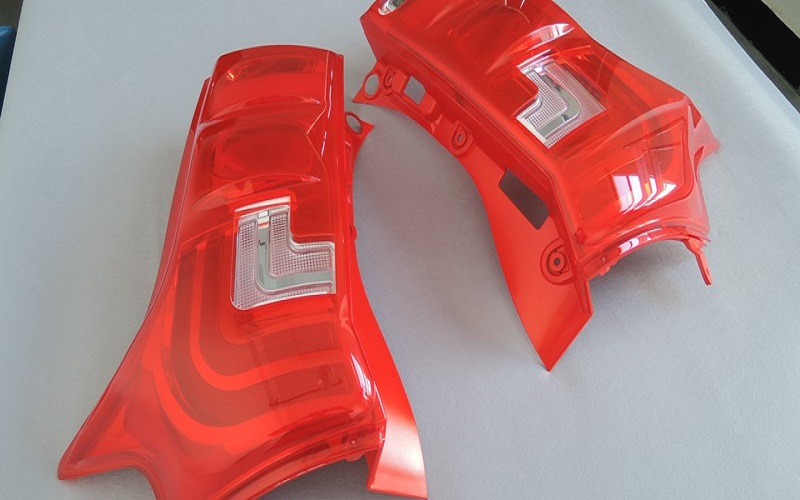
Materials Selection For Automotive Plastic Parts
Choosing the right materials for automotive plastic parts is a critical decision that impacts vehicle performance, safety, and overall quality. The selection process involves balancing performance, durability, and cost in demanding operational environments.
Understanding the properties and applications of different plastics enables manufacturers to make decisions that enhance component efficiency and longevity. Polyvinyl chloride (PVC) is chosen for its excellent chemical resistance, flame retardancy, and electrical insulation properties, making it suitable for various automotive applications.
Common Plastics Used In Automotive Components Manufacturing
Polypropylene (PP)
Polypropylene (PP) is a lightweight thermoplastic that is highly valued in automotive manufacturing for its excellent chemical resistance, flexibility, and cost-effectiveness. This material is commonly used in components such as bumpers, interior trim, and battery casings, where its properties can be fully leveraged.
Plastic injection molding enables the production of complex shapes, making PP ideal for various automotive applications.
Acrylonitrile Butadiene Styrene (ABS)
Acrylonitrile Butadiene Styrene (ABS) is renowned for its toughness, rigidity, and excellent impact resistance. This material is often employed in the automotive industry for components that require high durability and aesthetic appeal, such as dashboard panels, car bumpers, and decorative elements.
Polycarbonate (PC)
Polycarbonate stands out for its transparency, high impact resistance, and durability. These properties make it an excellent choice for vehicle safety features, such as headlamp lenses and other transparent components.
PC’s high-temperature resistance and dimensional stability make it suitable for demanding automotive applications.
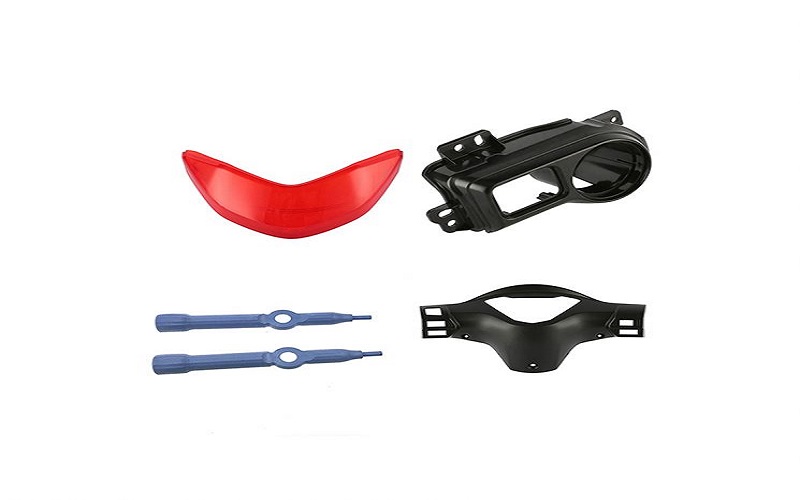
Innovations Material Of Plastic Automotive Parts
Sustainable Materials
Sustainability is a growing focus in the automotive industry, with manufacturers investing in the development of eco-friendly plastics and recycling initiatives. Composite materials with recycled content are increasingly used in electric vehicle components to enhance performance and reduce environmental impact.
The shift toward biodegradable plastics and recycled materials aligns with efforts to reduce the carbon footprint and promote a circular economy.
High-Performance Plastics
High-performance plastics are engineered to withstand extreme temperatures and prevent degradation, making them ideal for harsh environmental conditions. These materials enhance the longevity and reliability of automotive components, contributing to better overall vehicle performance.
Innovative plastic materials in battery housing and thermal management systems underscore their importance in modern automotive engineering.
Integration with Electric Vehicles
Electric vehicles (EVs) are driving the demand for lightweight and durable plastic materials to maximize efficiency and battery performance. Sustainable materials are becoming essential in EV design as manufacturers strive to reduce their environmental footprint while enhancing performance.
High-performance plastics in EVs highlight the industry’s commitment to innovation and sustainability.
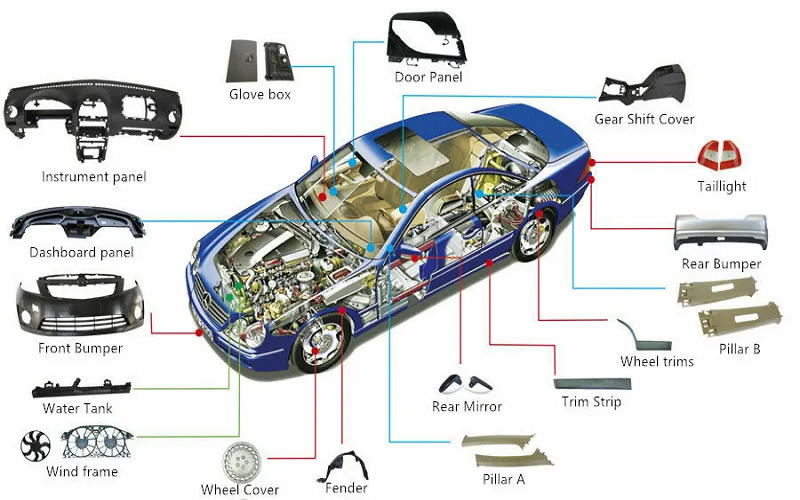
Benefits Of Plastic Automotive Components
Plastic components have become integral to modern automotive design, offering a range of advantages that enhance vehicle performance, efficiency, and sustainability. These benefits stem from the inherent properties of plastics and the versatility of their fabrication processes, making them a preferred choice over traditional materials like metal in many applications.
Lightweight Construction
The density of plastic materials is much lower than that of traditional materials such as steel, which can effectively reduce the overall weight of the vehicle, thus improving fuel efficiency and reducing fuel consumption and exhaust emissions.
For example, replacing a metal bumper with a plastic one can shave kilograms off a vehicle’s weight without sacrificing structural integrity.
Cost-Effectiveness
Plastic components provide economic benefits throughout the production cycle. Raw materials like ABS or polyethylene are often cheaper than metals, and injection molding enables high-volume production with low per-unit costs.
Plastics also eliminate costly secondary processes like welding or corrosion-resistant coatings, making them especially attractive for mass-market vehicles.
Corrosion Resistance and Durability
Unlike metals, plastics are inherently resistant to rust and corrosion, a critical advantage in automotive applications exposed to moisture, road salt, or harsh chemicals. Materials like polyamide (PA) and polycarbonate (PC) exhibit excellent durability, withstanding impacts, UV exposure, and temperature fluctuations over time.
This longevity reduces maintenance costs and enhances the reliability of components like fuel tanks, underbody shields, and exterior trim.
Improved Safety and Performance
Plastic components contribute to vehicle safety and performance in unique ways. Their ability to absorb energy during impacts—seen in bumpers or crash structures—enhances occupant protection by dissipating collision forces. Reinforced plastics, such as glass-fiber composites, provide strength comparable to metals while maintaining flexibility, making them ideal for structural roles.
Additionally, plastics’ thermal and electrical insulation properties support the integration of electronic systems, such as sensors or wiring, without interference, aligning with the rise of smart vehicles.
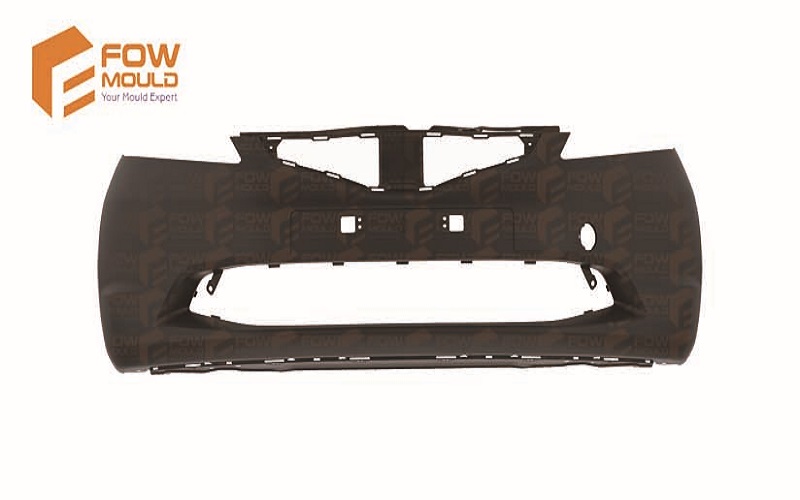
Applications of Automotive Parts And Components
The application of plastics in automotive parts is extensive and mainly includes the following areas:
Exterior Parts
Plastics are widely used in automotive exterior parts such as bumpers, step frames, and fenders. These components typically use modified PP materials due to their high toughness, high fluidity, and paint-free characteristics.
Interior Parts
Plastics are also extensively applied in interior parts, including dashboards, steering columns, door panels, pillars, and air conditioning systems. These components usually use PP materials for their high fluidity and excellent balance of rigidity and toughness.
Engine Compartment Components
The use of plastics in engine compartment components is also increasing, with applications in engine covers, cooling fans, and water chambers. These parts typically use engineering plastics like polyamide (PA), polyoxymethylene (POM), and polycarbonate (PC) due to their superior mechanical properties and heat resistance.
Electrical Components
Plastics are increasingly used in electrical components such as instrument panels, lamp housings, and door handles. These parts typically use ABS resin for its excellent electrical insulation and molding processability.
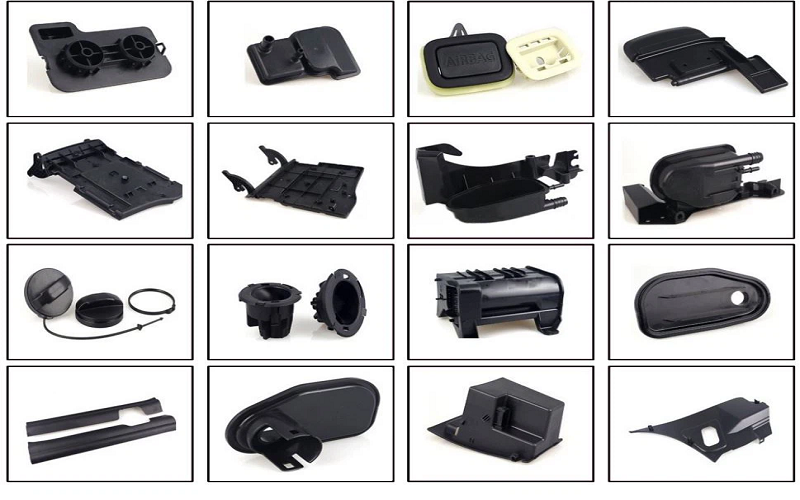
Manufacturing Processes for Automotive Plastic Parts
Manufacturers use various methods to create intricate and efficient plastic components. Advanced techniques like 3D printing are increasingly employed for rapid prototyping and custom component production.
These processes are essential for creating high-quality plastic automotive components with high precision and minimal waste.
Injection Molding
Injection molding is a manufacturing process that involves injecting molten plastic into an injection molded mold to create complex parts with high precision.
This technique dominates the industry due to its ability to produce complex, high-quality components with tight tolerances, making it indispensable for mass production.
Injection molding reduces waste and lowers manufacturing costs, making it efficient for high-quality automotive components. Its versatility with materials like PP, ABS, and PA solidifies its role in the sector.
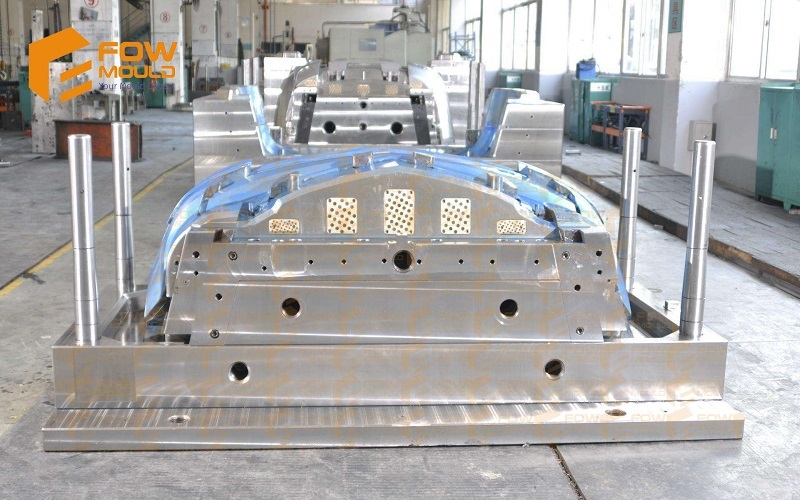
3D Printing
3D printing is increasingly used for creating prototypes and small quantities of custom parts, offering design flexibility and rapid production. This technology provides significant flexibility in design, allowing the creation of complex parts that traditional manufacturing methods may struggle to achieve.
3D printing in automotive manufacturing enables efficient production of innovative and complex components, reducing development time.
Blow Molding
Blow molding is a specialized fabrication technique tailored for producing hollow plastic parts, widely utilized in automotive manufacturing for components requiring internal cavities. Blow molding excels in creating seamless, lightweight structures with uniform wall thickness.
It is commonly applied to manufacture fuel tanks, air intake systems, and windshield washer fluid reservoirs, where its ability to form durable, leak-proof containers meets stringent safety standards.
Design Considerations In Plastic Automotive Parts
In the automotive industry, the design of plastic components is not only a critical aspect of the manufacturing process but also directly impacts vehicle performance, safety, and cost-effectiveness.
Effective plastic component design requires a balance between lightweight construction, durability, and production efficiency while meeting diverse demands such as aesthetics and functional integration. This section will explore the core factors in the design of automotive plastic components.
Structural Integrity and Performance
The design of automotive plastic parts must strike a delicate balance between lightweight construction and the demands of structural integrity, durability, and crash resistance. Engineers must ensure that plastic components can withstand mechanical stresses, vibrations, and extreme conditions over a vehicle’s lifespan.
Reinforced plastics like glass-fiber composites provide necessary strength without significant weight. Achieving this balance involves careful material selection and rigorous performance testing.
Tooling and Mold Design
Tooling and mold design are pivotal to the successful fabrication of automotive plastic parts, particularly in mass production environments where precision and efficiency are paramount. Injection molding, the most common technique, relies on high-quality molds crafted from steel or aluminum to produce parts with consistent dimensions and minimal defects.
Molds must be engineered with exacting tolerances for repeatability across thousands or millions of cycles. Overcoming challenges like complex geometries and thermal management requires collaboration between designers and toolmakers to optimize part geometry for manufacturability.
Aesthetic and Functional Integration
Beyond structural concerns, the fabrication of automotive plastic parts must address aesthetic appeal and seamless integration with functional systems. Surface finishes and textures play a dual role: enhancing visual appeal and improving usability. Techniques such as in-mold decoration or post-molding painting create premium finishes for interior components, while UV-resistant coatings are essential for exterior parts.
Integration with electronic components necessitates precise design of mounting features and selection of non-conductive or EMI-shielding materials. This holistic approach ensures both form and utility in the final product.
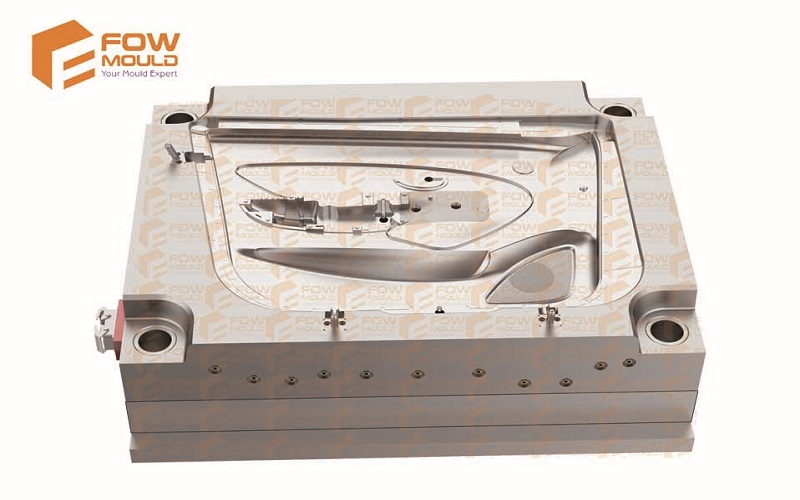
Choosing the Right Plastic Material for Automotive Applications
The choice of plastic materials in the automotive industry significantly affects performance, safety, and overall quality.
Advanced plastics can withstand extreme temperatures and harsh chemicals, making them suitable for critical automotive applications.
Auto Parts Manufacturers must consider factors such as performance, environmental and regulatory compliance, and cost-effectiveness when selecting materials for automotive applications.
Performance and Durability
Performance and durability are critical when choosing plastic materials for heavy-duty automotive applications. Polypropylene, for example, is lightweight, has good chemical resistance, and low moisture absorption, making it a desirable choice for durable automotive components. These factors impact the lifecycle and reliability of parts, ensuring they withstand demanding operational environments.
Environmental and Regulatory Compliance
Aligning material choices with environmental considerations is increasingly essential in the automotive industry. Plastics should be chosen for their recyclability to comply with sustainability initiatives and reduce environmental impact.
This is especially important for electric vehicles, which aim to minimize their ecological footprint while maintaining high performance.
Cost-Effectiveness and Availability
Plastic parts and components are considered cost-effective in automotive manufacturing due to less energy required during production, greater precision in molding, and easier assembly.
The availability of various plastic materials allows manufacturers to choose based on specific performance and cost criteria, supporting efficient production and competitive pricing in the automotive industry.
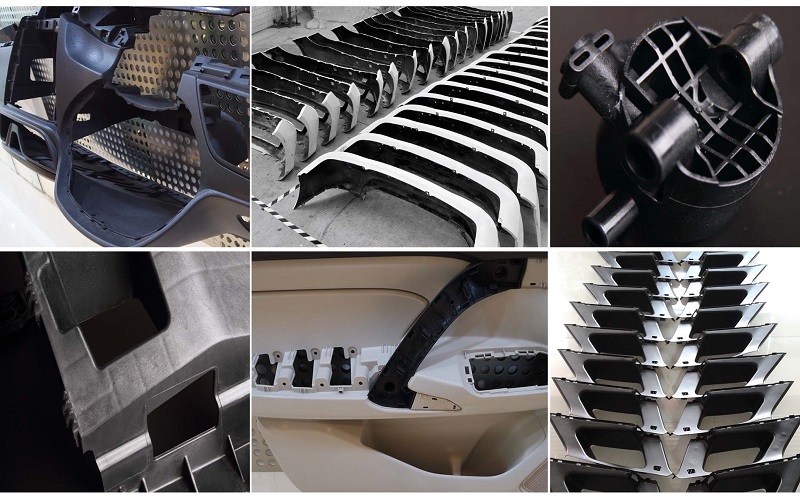
Summary
Plastic parts have transformed the automotive industry with their lightweight, cost-effective, corrosion-resistant, and safety-enhancing properties, boosting both performance and sustainability. Strategic material choices and advanced manufacturing techniques—such as injection molding, 3D printing, and blow molding—enable the production of high-quality components that meet modern vehicle demands.
As the industry evolves, innovations in material science, sustainable materials, and high-performance plastics for electric vehicles will further elevate their role. By leveraging these advantages and optimizing material and manufacturing decisions, we can steer automotive design toward greater efficiency, sustainability, and performance.
